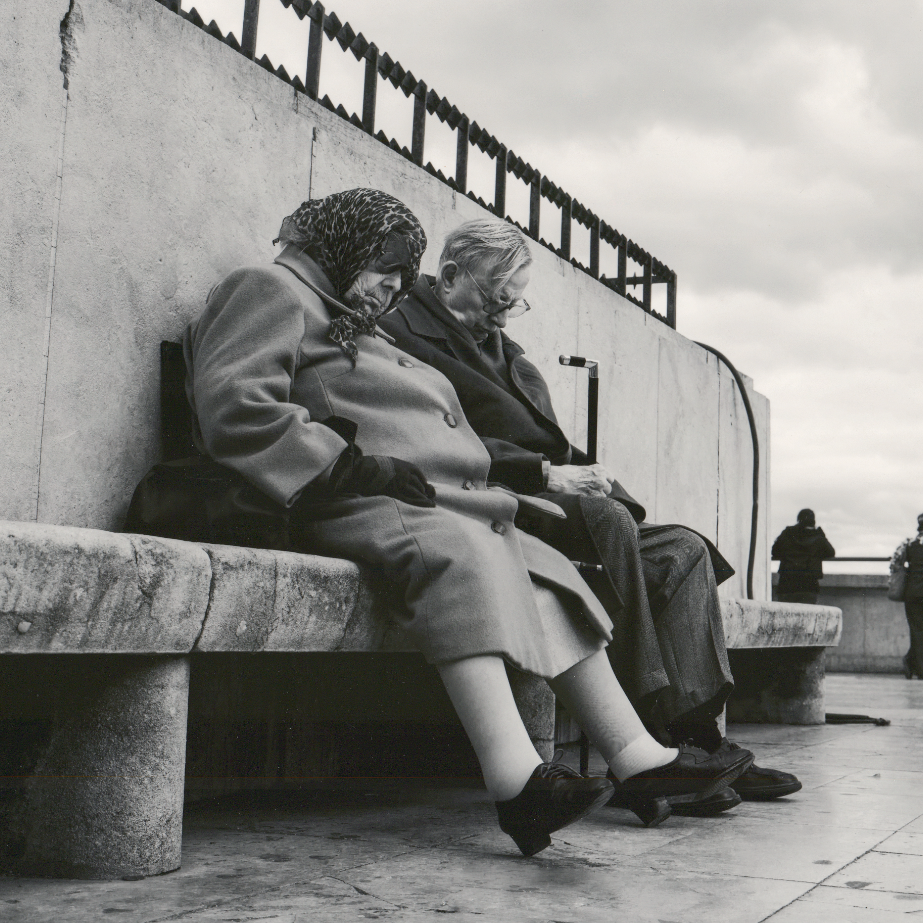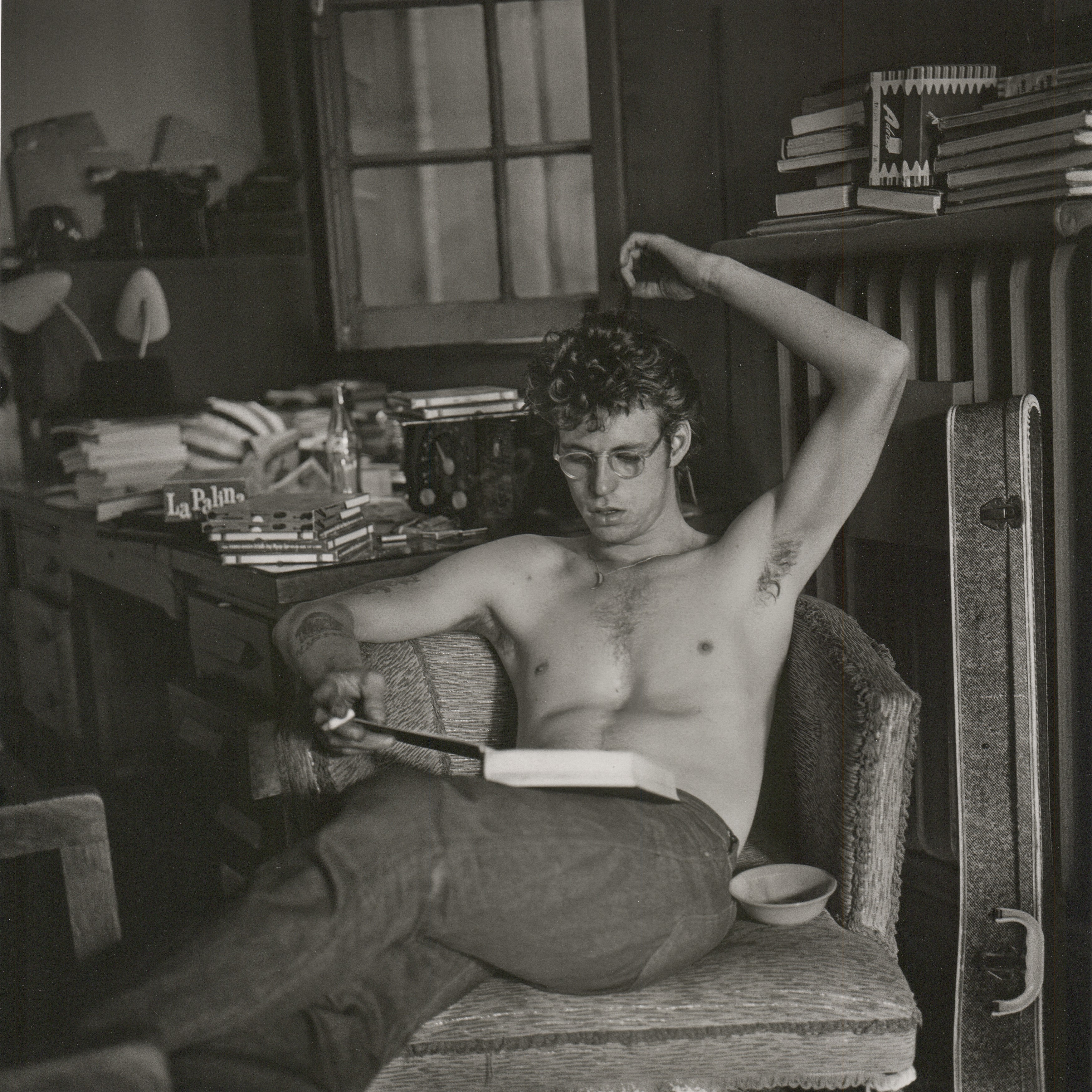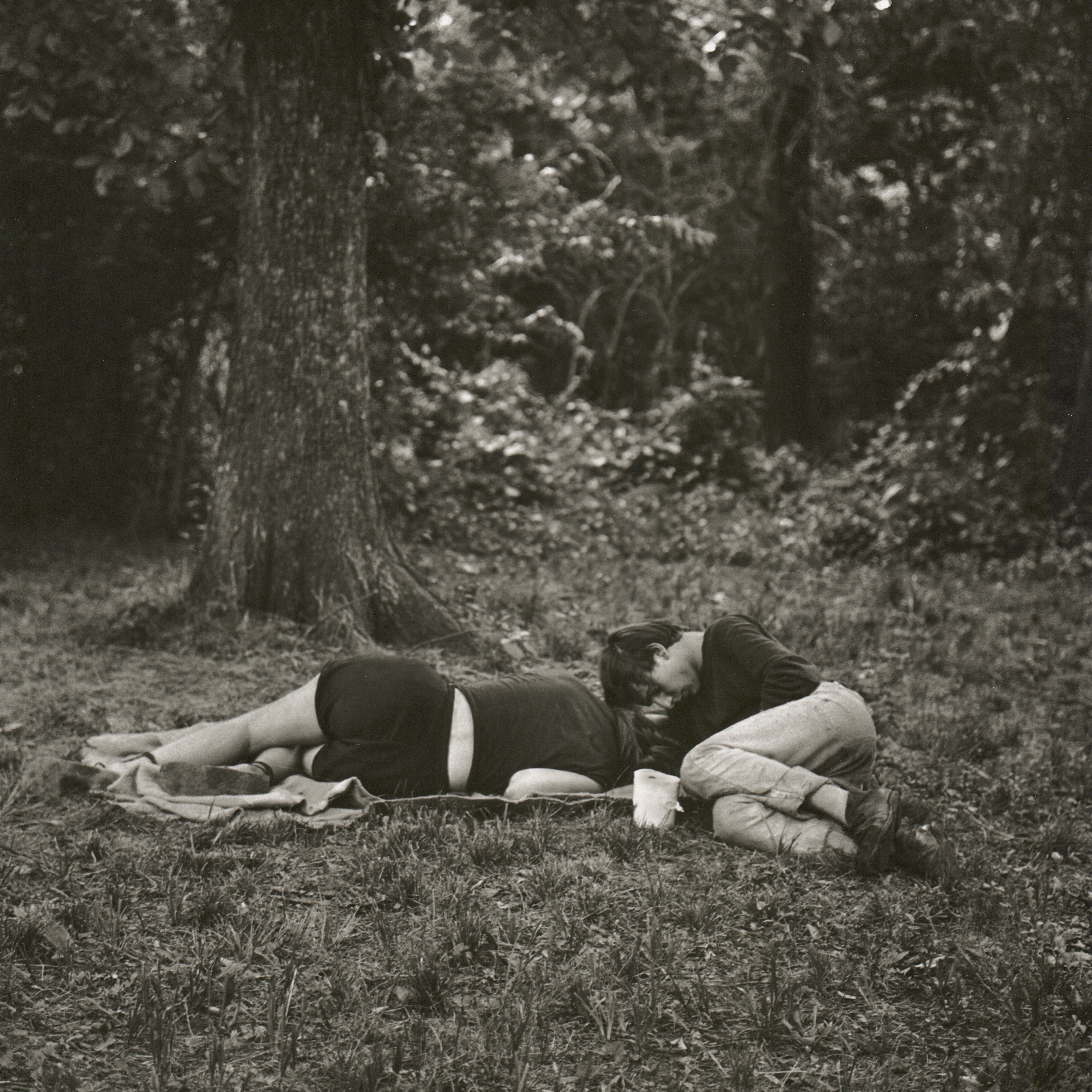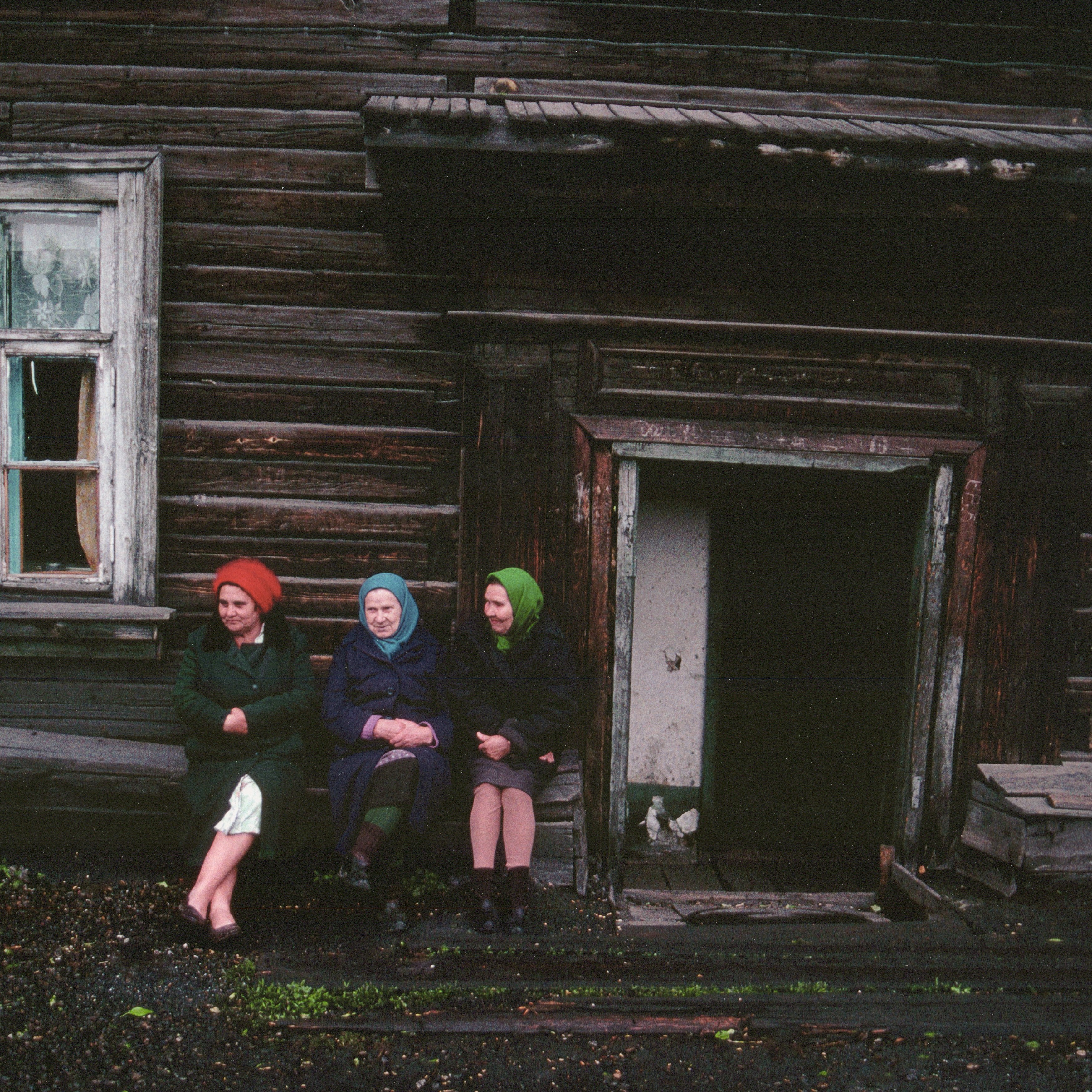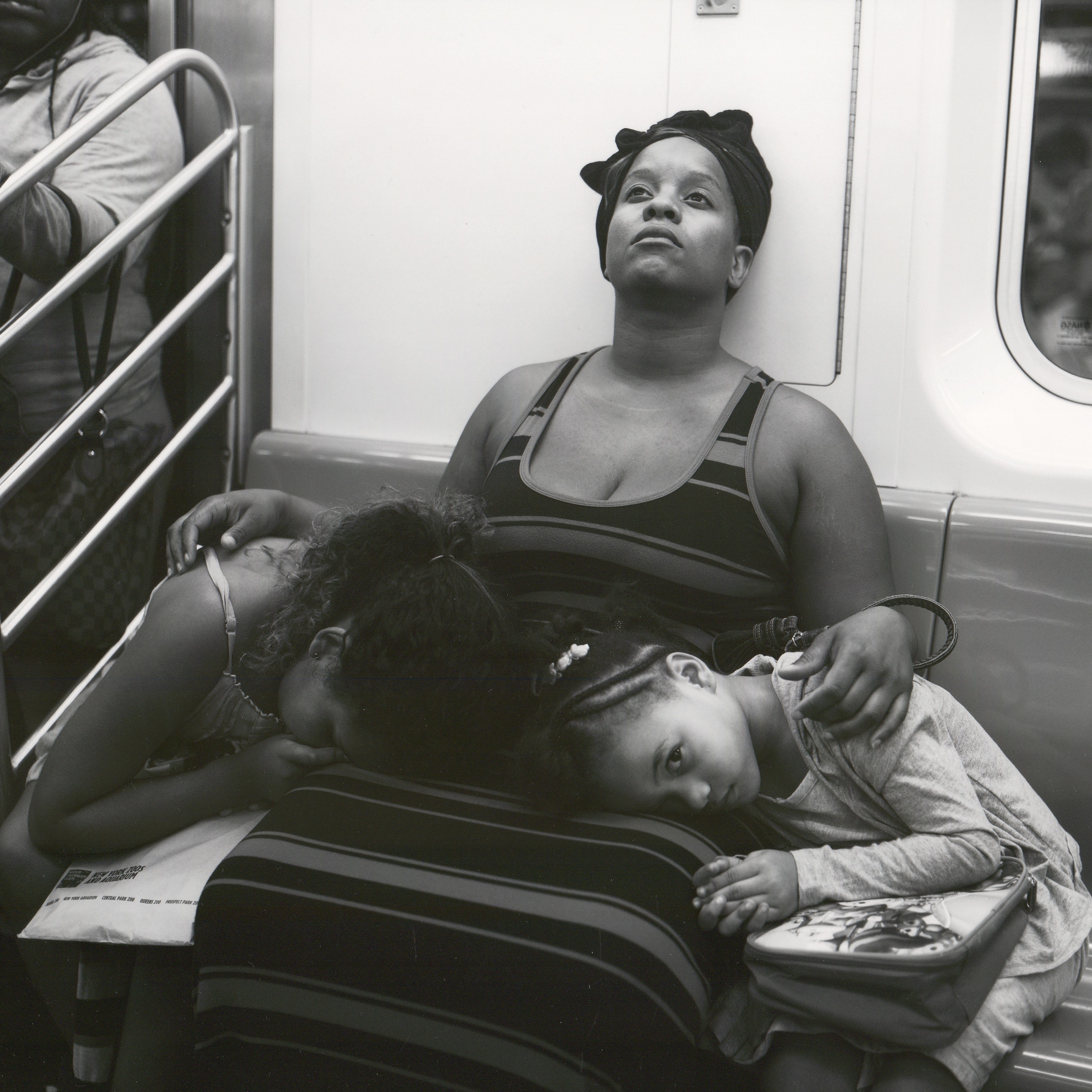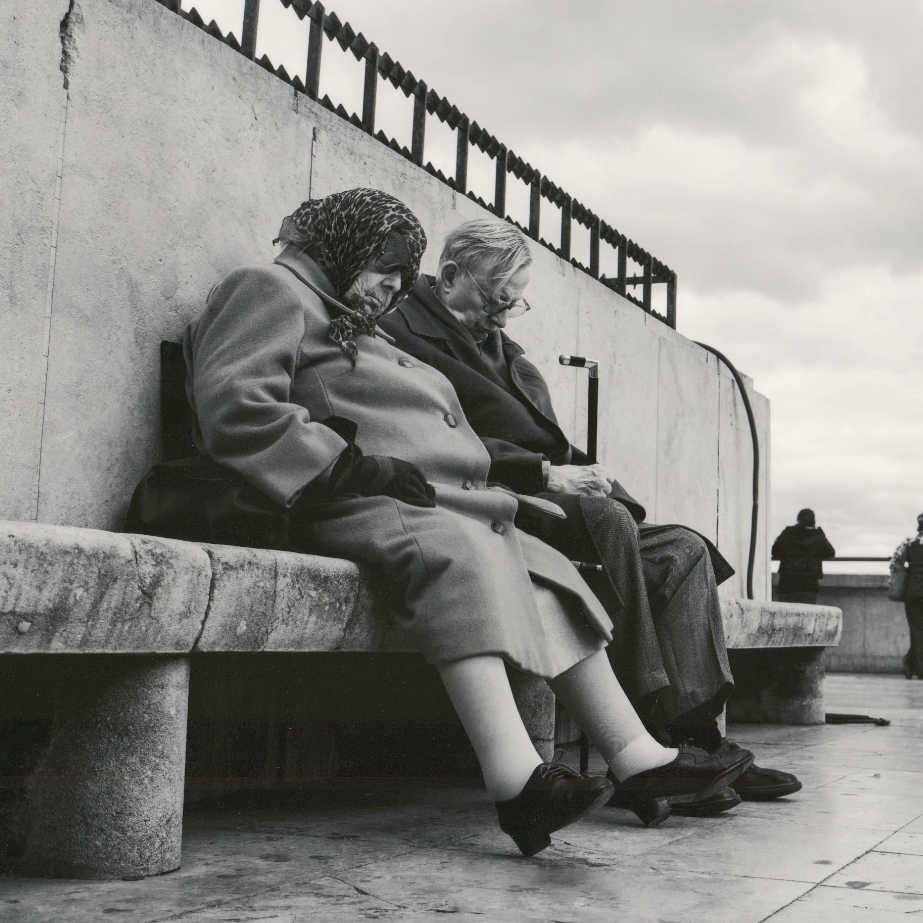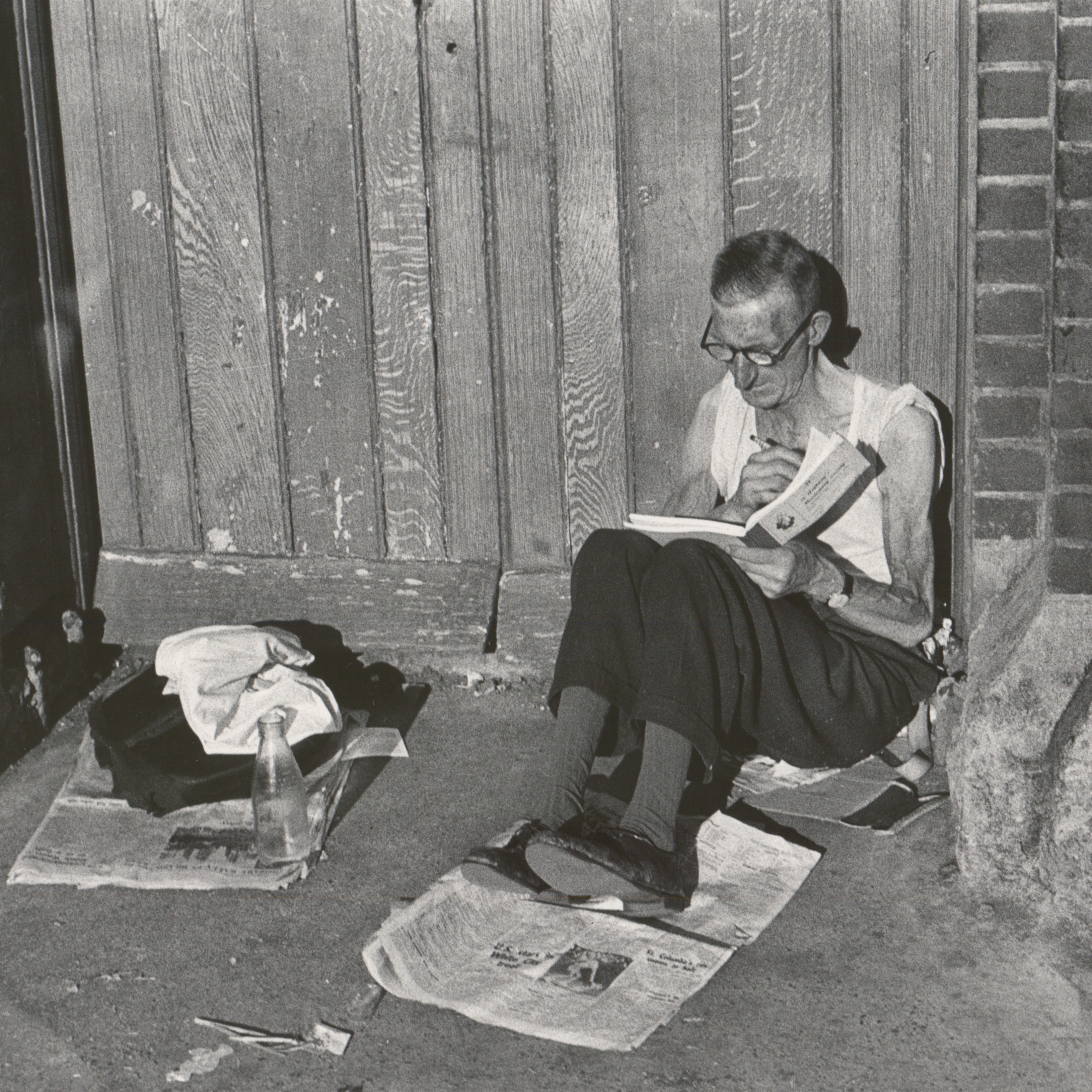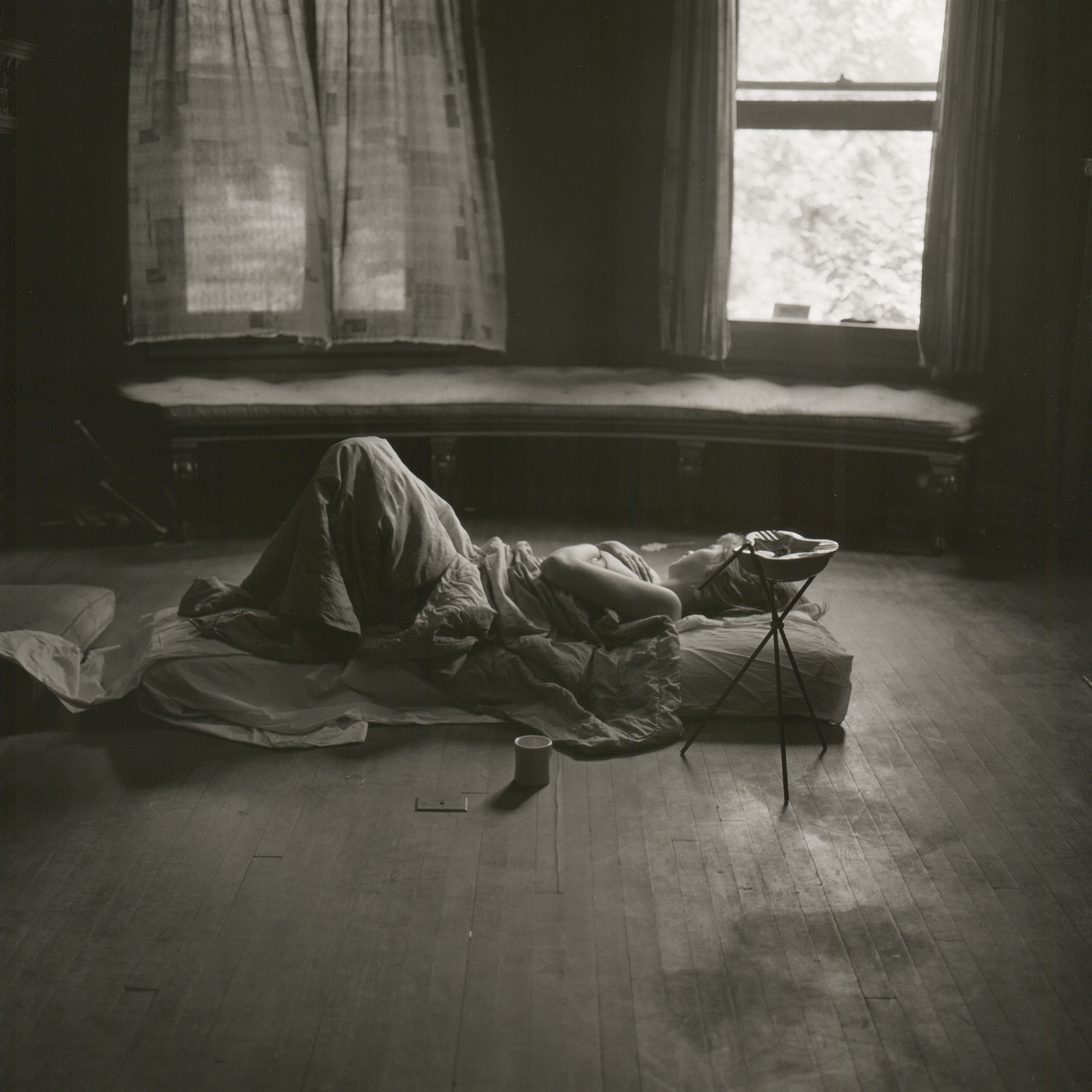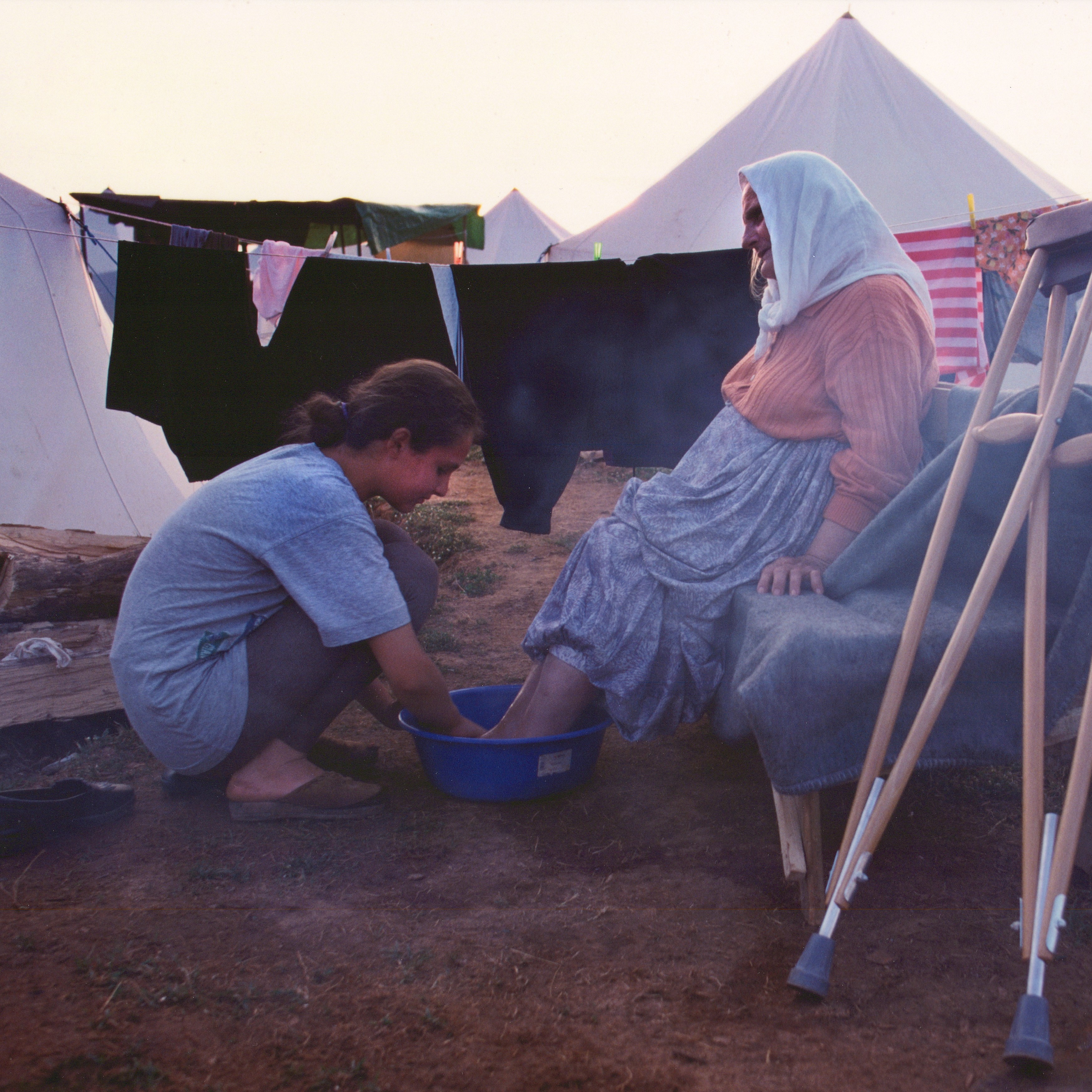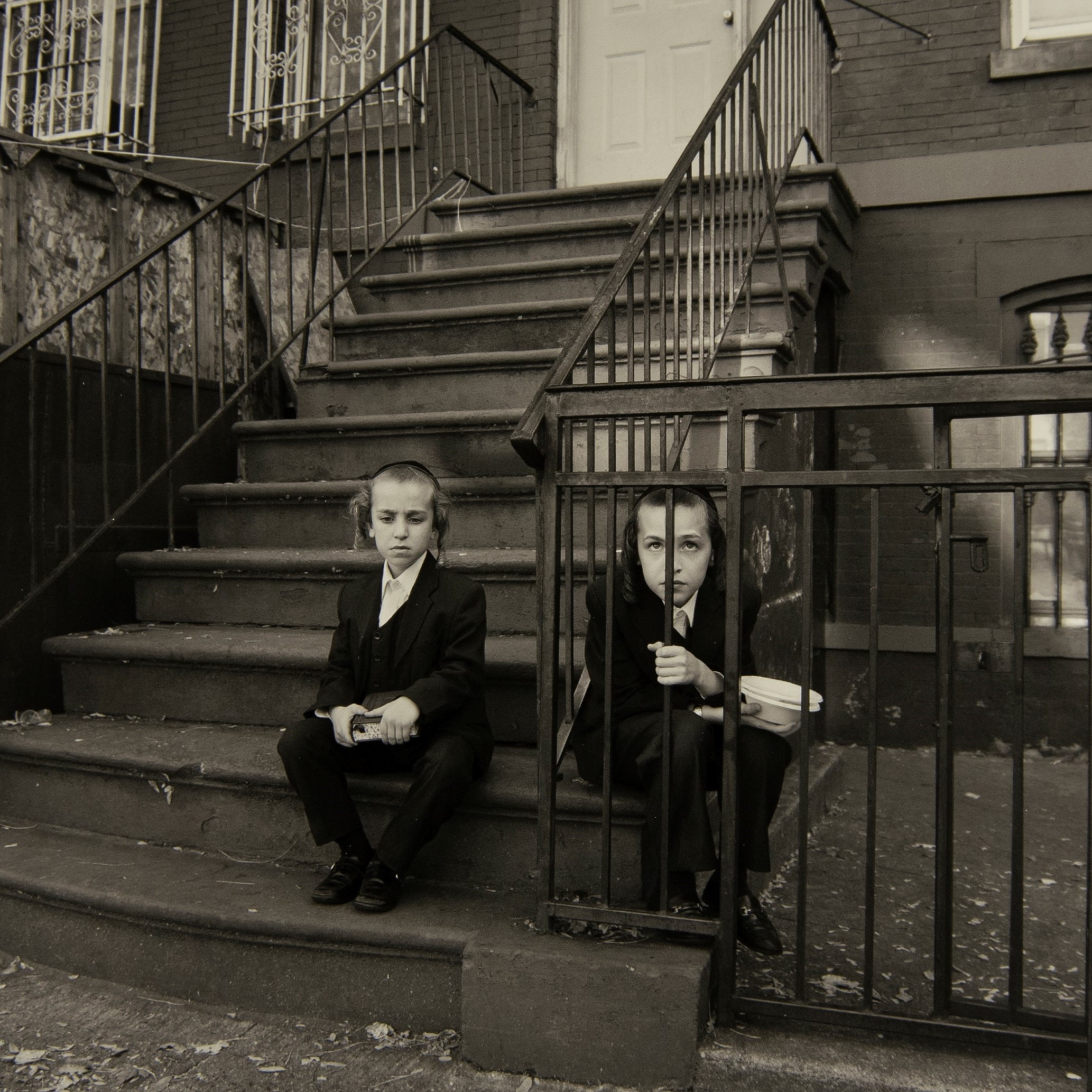Larry Fink, Turk, Chicago, Illinois, 1958, archival pigment print
Larry Fink captured this moment of a man existing in his own bubble, yet the context behind it is unsure. This could have been a posed scene, or simply a candid moment of Fink experimenting with the camera. This work perfectly represents the strange idleness of being alone and relaxing. The cigarette between the subject’s fingers, the book he has almost completed, his exposed abdomen, and the absentminded hair-twirling showcase exactly the carefree relaxation of being in one’s own space where they feel comfortable. This image invokes a rainy Sunday afternoon, with nothing to do but finish one’s book and exist in a completely natural state.
Larry Fink, Missouri, 1958, archival pigment print
The couple seems to have no clue about photographer Larry Fink’s presence as he photographed this intimate moment. The person reclining on the blanket might be asleep, or simply relaxing. Their partner reclines just above them, looking down on them as if sharing a secret or simply admiring. The small clearing provides privacy to this moment, and makes this candid artwork so beautiful. Their act of partaking in repose together indicates the intimacy of lovers or the closest of friends.
David Quick, Untitled, from The Incidental American Portfolio, 1970s, gelatin silver print
David Quick’s photograph of a man relaxing on a wooden bench on a pier was taken in Wildwood, New Jersey in the 1970s. His relaxed position on the bench and the lack of passersby allude to a moment of peace from the perpetual movement of reality. This work provides a prime example of the small moments of solitude and inactivity one can find.
Peter Turnley, Siberian women live in a poor coal-mining and steel-manufacturing town enduring widespread hardships, Novokuznetsk, Russia, 1981, archival pigment print
Peter Turnley’s works are renowned for accurately capturing the realities of the human condition. The state of the building and the heavy coats the women wear indicate the hardships of their lives, yet they are adorned with bright colors and seemingly cheerful as they sit on the bench. The frozen moment provides a sense of relief, as the three women seem to be very close and utilizing this moment to enjoy each other’s company.
Peter Turnley, New York, 2014, archival pigment print
In this photograph, Peter Turnley’s candid capturing of a traveler’s fatigue indicate the necessity in modern life of finding respite in the moments in between. As the two young girls recline on the woman’s lap, and she leans her head on the wall behind her, they are embodying the very theme of this exhibit. Their exhaustion and the woman standing to the left indicate the business of the train car and people going about their lives all around. Within this small moment, there is a sense of time being frozen as they wait for their destination.
Peter Turnley, Centro Habana, Cuba, 2012, archival pigment print
As the small girl waits in the bicycle taxi, the street is busy behind her. She is unaccompanied, presumably waiting for something or someone. Turnley depict a fleeting moment of isolation and peace that feels moments away from changing, as if someone is just about to enter the frame.
Peter Turnley, Paris, France, 2015, archival pigment print
Peter Turnley lived more than half his life in Paris, and considers it a second home. His photographs of Parisian life maintain his devotion to the human condition, but seem influenced by the romance that this city holds for many. This depiction of two lovers in a café is a simple representation of people going about their day, yet there is beauty within this moment of rest and rejuvenation.
Peter Turnley, Esplanade de Trocadero, Paris, France, 2012, archival pigment print
This photograph of a couple sitting with the Eiffel Tower in the background gives a sense of much needed ease, perhaps from walking all over the city. Their postures, especially the mans’, indicate that they might have fallen asleep, and that this moment of respite was necessary. The children playing with each other and relaxing in the background provide a contrast to the elders’ rest. The sense of timelessness that this work holds, with several generations in one work and the unmistakable landmark behind them, not only captures the repose of others, but invites the onlooker to pause and rest as well.
Alen MacWeeney, Lunchtime, a Place in the Sun, Dublin, 1963, archival pigment print
Irish photographer, Alen MacWeeney, rendered this photograph of a man spending his lunchtime on a door stoop reading a booklet. The title of this work indicates the warmth of the sun that was sought for a moment of leisure. The composition conveys a sense of the man being tucked away from the wind, and soaking up the natural warmth from the sunlight. The man seems absorbed in his book, so much so that he does not look up at MacWeeney, whose shadow is on the right side of the image. In a world where ease can be so hard to come by, the need to take whatever is available and enjoy it is pertinent.
Ralph Gibson, Untitled, from MONO, 2013, archival pigment print
This artwork of a woman basking nude in the sun illustrates Ralph Gibson’s artistic approach of capturing evocative and surreal photographs in monochromatic styles. As the woman lays in the sun, her hair is laid out on the ground in a natural way that indicates she is completely at ease. The shadow lines from the window panes fall across the woman, indicating that she might be inside, simply enjoying the sun on her body. The moment seems candid, as if she could fall asleep in that position. Gibson’s photograph depicts the universal, timeless experience of reclining under the sun as humans have done for thousands of years.
Larry Fink, Mary, St. Louis, Missouri, 1958, archival pigment print
Larry Fink’s photograph of a woman sleeping on a mattress on the floor of a barren room is powerful, evoking a sense of melancholy. As she lays there, she is looking towards the window, as if lost in thought. She seems to be at peace, but it is unclear what her life is like outside of this moment. The nakedness of the room and her positioning between a covered window and an open one indicates the idea of passage, from one thing to another, from one stage to another. This moment of peace even in an unlikely situation is a small comfort, yet it is immediately understandable and sympathetic.
Peter Turnley, A Kosovar-Albanian young woman washes the feet of her grandmother in a refugee camp during the war in Kosovo, Kukes, Albania, 1999, archival pigment print
The photograph has a profound feeling of sacrifice and leisure in a desperate time. As the grandmother sits while the young woman washes her feet, a pair of crutches indicating the grandmother’s ailing body and the uncomfortable crouched position of her granddaughter provide a deeper understanding of the love shared between these women, and how valuable this rest and care is for the grandmother. This work’s setting in a refugee camp highlights the potential danger these women are facing and the perilous situation in which respite becomes even more highly prized.
William Castellana, Two Boys Sitting on Stairs, 2013-14, archival pigment print
William Castellana’s work of two Hasidic Jewish boys sitting on a staircase in their neighborhood in Brooklyn was strictly an outsider view into their lives. One of the boys is holding a bowl, the other a book. Their curls and yarmulkes distinguish them as Hasidic, and their dress indicates an event or service of some kind. Despite their formal clothing, they find rest where they can. These children reclining on a stoop provide a familiar feeling of relaxing while waiting for a friend, a parent, and so on. The sense of patience and waiting is palpable, yet the desire to sit for a minute cannot be ignored.
